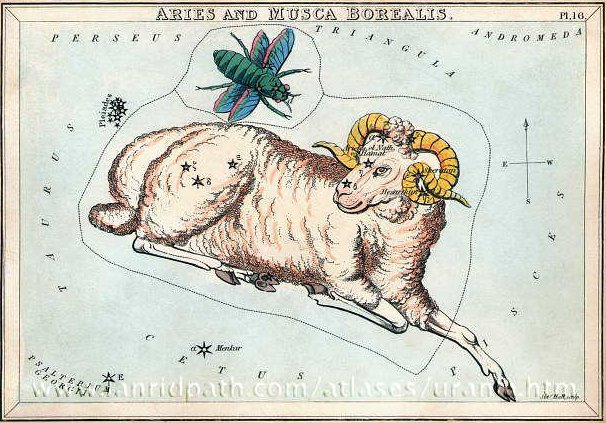3. The meek Ram is oriented in the opposite direction compared to that of the male Bull and the Fishes also turn their backs on Taurus:
I think they form a kind of 'Janus' sign together with Taurus - once the stars in Aries and Pisces could have been marks for where the old (winter) year ended, with these constellations looking back to what had been instead of facing in the forward direction. The flabby strings emerging from Alrisha are in contrast to the firm horns of the Bull. G has a pair of similar figures where α Arietis (Hamal, the sheep) and α Piscium (Alrisha, the knot) should be located:
30.5 * 72 = 2196 or ca 300 B.C. could have been a limit for the 'Age of Aries' (never a success). If people had refused to let go of the Pleiades as the sign for the beginning of the new year, then this stubborn mental disposition would surely have resulted in the Ram and the Fishes being imagined as looking to the past instead of to the future. The pair of figures sitting down in Gb7-27 and Gb7-29 do not look like youngsters, rather like old people spending their remaining time eating and looking at the stars, keeping a firm grip on things of the past. In such a past the Pleiades could have represented the abode of the living spirits (manu rere), who assembled there immediately before making their return to the land of the living. According to G only a week remains until the text at the top of side b is ending and the tablet turns to the beginning of side a (corresponding to the 'land of the living', the front side of the year):
The end of the Age of Taurus is evidently marked by λ and ν Tauri which today are rising heliacally close to the 4h line, 20 weeks after January 1. The gateway from winter to summer around 2600 B.C. could have been formed by Hyadum I and Hyadum II. Counting Gb8-30 (where 8 * 30 = 240) twice establishes a symmetry with the preceding pair of ihe tau maro glyphs, presumably to be understood as a negation - maro - of death, cfr Eb6-2:
The ihe tau sign could represent a 'broken canoe' (a dead chief). A pair of dead chiefs (one fat and one lean) could correspond to the pair of 'years' (summer respectively winter). ... The hull of the canoe was regarded as the backbone of their chief. In laments for dead chiefs, the deceased are often compared to broken canoes awash in the surf ... Reading the text according to my interpretation will transport the reader to a fresh beginning at the bottom of side a, and then repeating what took place in the sky when Taurus ruled. |

.jpg)






